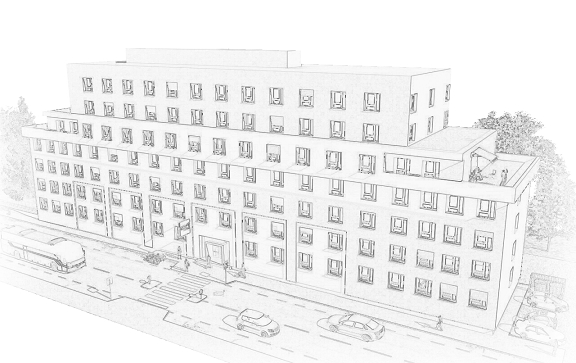
The TEM infrastructure is part of an extensive range of microscopy instrumentation, specimen preparation equipment and computing hard- and software, which belongs to the TU Graz and the supporting Graz Centre for Electron Microscopy (ZFE).

FEI Nova200 FIB: A dual-beam Focused Ion Beam (FIB) Nova200 FIB equipped with various gas injection systems (GIS) and a versatile custom GIS system. An OmniProbe micromanipulator for in-situ lift-out of the specimen and TEM lamella transfer, a Fischione Nanomill and conventional sample preparation facilities including a Gatan Precision Ion Polishing Systems, Fischione plasma cleaner, Leica sputter coater, Buehler diamond wire saws, ultra-sonic grinders, Allied MultiPrep System TEM wedge polisher, Struers Tenupol electrolytic polishers, and Leica Cryo-Ultramicrotomes. For cryo preparations a Leica freeze plunge system is available as well.
ASTEM - FEI Titan cubed: This unique 60-300 kV TEM has been specially designed to perform analytical studies at the highest level. This instrument is equipped with a high brightness Schottky-emitter (X-FEG), a variable gun-lens with monochromator plus a spherical aberration corrector for the electron probe yielding a STEM resolution of 0.07 nm and an energy-resolution of less than 0.20 eV. The microscope is fitted with a Lorentz-lens and the latest generation of energy-filter GIF Quantum ER-965 DualEELS system and it can run multi-modal STEM/EDX/EELS/CBED acquisitions. It also features highly efficient X-ray detectors (Super-X), as well as BF and DF/HAADF STEM detectors and it comes with an array of TEM sample holders, featuring in-situ heating and tomography capabilities. A particular asset is the installation of a direct-electron-detection camera in the spectrometer (K2 by Gatan) to allow for high-SNR recordings of spectral data, important for monchromated EELS applications and imaging.
Mono-TEM FEI Tecnai F20: This 200 kV microscope is fitted with a Schottky FEG and a Wien-filter monochromator, a STEM-setup, EDX detector and a GIF Tridiem 863, which can be used for high energy-resolution EELS and EFTEM studies. The microscope is optimized for EFTEM spectrum imaging via special software routines. Besides usual single and double tilt specimen holders, heating and cooling holders and a cryo-transfer specimen holder are available. A scanning precession system (SpinningStar / Nanomegas) is available for “kinematic” electron diffraction.
Cryo-TEM Tecnai T12: This microscope is laid out for low voltage / low dose investigations of beam sensitive materials that preferably have to be investigated under cryo conditions.
The FELMI has long experience in data analysis, particularly for EELS and EDXS spectral data sets in 2D and 3D. Knowledge to support experimental data interpretation via simulations with elastic and inelastic calculation packages is readily available (QSTEM, µSTEM, JEMS). Application of the most advanced mechanisms for 2D and 3D data interrogation via Matlab, DM or Phyton scripts is routinely provided. The FELMI-ZFE furthermore hosts and provides access to the largest script database for customized programs, running under DigitalMicrograph by Gatan.
Much of the provided infrastructure below emerged from FELMI´s active role in the definition of hard-and software and collaboration with microscope (ThermoFisher/FEI) and accessory (Gatan, Bruker, Fischione) vendors. The profound knowledge about the interplay of components and their best applicability to scientific questions, is one of the key assets for our services.
The FELMI scientists´ expertise lies in analytical transmission electron microscopy and thin film specimen preparation, ESEM in-situ investigations, nanostructuring and additive manufacturing of materials with FIB, polymer microscopy and chemical imaging of biomaterials (Raman and FTIR), cryo-scanning probe microscopy and AFM techniques. In TEM, profound knowledge in EELS and EFTEM spectroscopy and imaging, EELS near-edge fine structure analysis, valence EELS of plasmonic nanostructures, quantitative X-ray analysis, material science electron tomography, high resolution TEM imaging, diffraction and simulation and in-situ observations was built up. Materials expertise: semiconductors, solar cell materials, hybrid materials, steels and alloys, polymers, functional inorganic materials and interfaces in hybrid materials.
With the installation of a novel direct-electron detection camera, the second of its kind in Europe, users will get access to unprecedented, low-noise data and novel applications. This will open up new ways of research, where subtle signal changes (orbital mapping, DPC,…) play a role. The planned extension of the infrastructure with cryo-capable specimen preparation equipment will further improve the quality level of beam sensitive sample preparations.
Three key instruments will be added to the infrastructure in the first half of 2018, ready for use at the start of the project. 1.) Direct-electron detection camera (K2 by Gatan), upgrade to the ASTEM DualEELS spectrometer 2.) Thermo Scientific Velox user interface, upgrade to install differential phase contrast imaging, enhanced sample drift-correction and quicker instrument tuning tools 3.) PIPS II Cryo ion mill by Gatan.
- How Transnational Access works?
- Request for access
-
Installations
- Access to StEM Stuttgart
- Access to ERC Juelich
- Access to CEMES Toulouse
- Access to LPS Orsay
- Access to EMAT Antwerp
- Access to OXTEM Oxford
- Access to WEMS Cambridge
- Access to K7 Ljubljana
- Access to FELMI-ZFE Graz
- Access to LMA Zaragoza
- Access to Advanced DME Cadiz
- Access to IC-EM Krakow
- Access to CMAL Chalmers
- Access to Gemini Centre Trondheim
- Access to Beyondnano EM lab Catania
